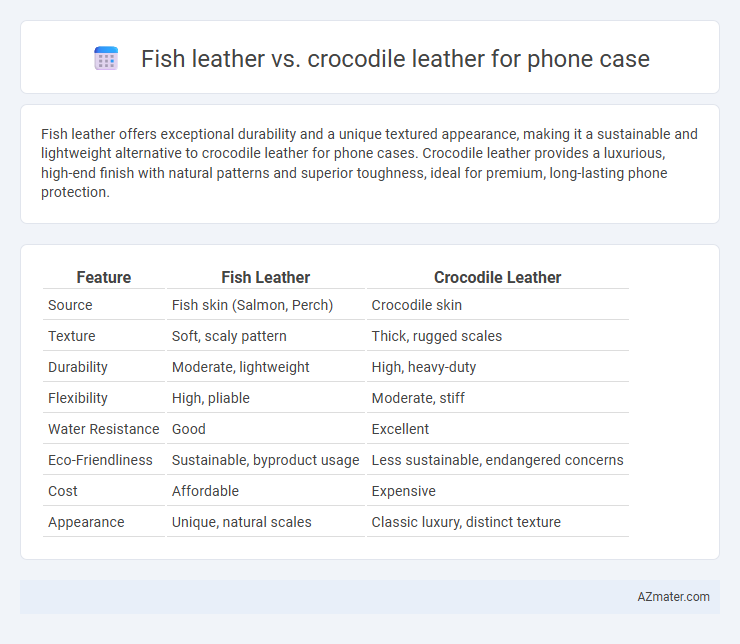Fish leather offers exceptional durability and a unique textured appearance, making it a sustainable and lightweight alternative to crocodile leather for phone cases. Crocodile leather provides a luxurious, high-end finish with natural patterns and superior toughness, ideal for premium, long-lasting phone protection.
Table of Comparison
| Feature | Fish Leather | Crocodile Leather |
|---|---|---|
| Source | Fish skin (Salmon, Perch) | Crocodile skin |
| Texture | Soft, scaly pattern | Thick, rugged scales |
| Durability | Moderate, lightweight | High, heavy-duty |
| Flexibility | High, pliable | Moderate, stiff |
| Water Resistance | Good | Excellent |
| Eco-Friendliness | Sustainable, byproduct usage | Less sustainable, endangered concerns |
| Cost | Affordable | Expensive |
| Appearance | Unique, natural scales | Classic luxury, distinct texture |
Introduction: The Rise of Unique Leathers in Phone Cases
Fish leather offers a sustainable and lightweight alternative to traditional crocodile leather, boasting a distinctive scale pattern that appeals to eco-conscious consumers. Crocodile leather remains a symbol of luxury and durability, prized for its rich texture and natural toughness in high-end phone cases. Both materials provide unique aesthetics and performance, reflecting the growing demand for innovative, exotic leathers in the accessories market.
Overview: What is Fish Leather?
Fish leather is a durable and eco-friendly material made from the skin of various fish species, such as salmon, carp, and perch, known for its unique scale patterns and natural texture. It offers a sustainable alternative to traditional exotic leathers like crocodile, featuring high tensile strength and water resistance ideal for phone cases. The tanning process of fish leather utilizes minimal chemicals, enhancing its appeal as a biodegradable and lightweight option for stylish and functional phone accessories.
Overview: Understanding Crocodile Leather
Crocodile leather, renowned for its durability and unique scale patterns, is a premium material choice for phone cases, offering a luxurious and highly resistant surface. Its natural texture varies by species but often features irregular, raised scales that enhance grip and aesthetic appeal. This exotic leather requires specialized tanning processes to maintain flexibility and strength while preserving its distinct appearance.
Durability: Fish Leather vs Crocodile Leather
Crocodile leather offers superior durability for phone cases due to its dense fiber structure and resistance to scratches and wear, making it ideal for long-term use. Fish leather, while softer and more flexible, typically has less tensile strength and may be more susceptible to abrasion and damage over time. Choosing between the two depends on the desired balance of durability and texture, with crocodile leather excelling in robustness and fish leather providing a unique, lightweight alternative.
Texture and Appearance Comparison
Fish leather offers a distinctive texture characterized by a unique scale pattern that is typically softer and more flexible than crocodile leather, making it ideal for lightweight phone cases. Crocodile leather features a rugged, raised scale texture with a glossy finish, known for its durability and luxurious appearance, often associated with premium fashion accessories. The visual contrast between fish leather's subtle, intricate scales and crocodile leather's bold, pronounced texture allows consumers to choose between understated elegance and striking opulence in phone case design.
Sustainability: Eco-Friendliness of Both Leathers
Fish leather offers a highly sustainable alternative for phone cases due to its minimal environmental footprint and the efficient use of byproducts from the fishing industry. Crocodile leather, while durable and luxurious, often involves intensive farming practices with significant water consumption and habitat disruption. Choosing fish leather supports eco-friendly production by reducing waste and relying on renewable resources, making it a greener option for environmentally conscious consumers.
Price and Market Availability
Fish leather offers a more affordable alternative to crocodile leather for phone cases, with prices typically ranging from $30 to $70 compared to crocodile leather's $150 to $500 price range. The market availability of fish leather phone cases is growing due to sustainable sourcing and rising demand for eco-friendly materials, whereas crocodile leather remains a niche luxury segment with limited supply constrained by regulations and ethical concerns. Consumers seeking cost-effective and unique textures often prefer fish leather, while those investing in high-end, exclusive products gravitate towards crocodile leather despite higher prices and limited availability.
Maintenance and Care Requirements
Fish leather phone cases require gentle cleaning with a damp cloth and regular application of a natural conditioner to maintain their flexibility and prevent drying. Crocodile leather cases demand more intensive care, involving specialized leather cleaners and conditioners to preserve the scales' texture and prevent cracking. Both leathers benefit from avoiding prolonged exposure to water and direct sunlight to extend their lifespan and maintain appearance.
Ethical Considerations in Sourcing
Fish leather offers a more sustainable and ethical alternative to crocodile leather, as it typically utilizes byproducts from the fishing industry, reducing waste and minimizing environmental impact. Crocodile leather often involves concerns about animal welfare and endangered species protection, with sourcing sometimes linked to unethical farming or illegal poaching practices. Choosing fish leather for phone cases supports responsible sourcing initiatives and promotes the use of renewable, eco-friendly materials.
Conclusion: Choosing the Right Leather for Your Phone Case
Fish leather offers a lightweight, eco-friendly, and uniquely textured option for phone cases, providing durability with a distinct scale pattern. Crocodile leather, prized for its luxurious appearance and exceptional toughness, ensures high-end elegance and long-lasting protection. Selecting the right leather depends on balancing sustainability, aesthetic preference, and durability requirements for your phone case.

Infographic: Fish leather vs Crocodile leather for Phone case
 azmater.com
azmater.com